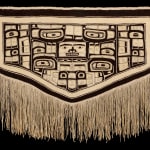UNIDENTIFIED TLINGIT ARTIST, CHILKAT KWAAN
ESTIMATE: $30,000 — $50,000
PRICE REALIZED: $32,000.00
The technique of twined tapestry known as Chilkat weaving (Naaxein in Tlingit) is one of the most complex styles of fabric decoration known in the world. Oral history tells us that the specialized braiding techniques that enable the weaving of circles and other rounded forms found in Northwest Coast two-dimensional design were developed by Nishga’a weavers in the Nass River valley, sometime around the latter part of the eighteenth century. Within a few generations, basic design forms had been mastered and refined into accurate reproductions of painted crest images in woven form. By the first decades of the nineteenth century, the characteristic five-sided border shape and distribution of complex formline imagery had evolved into the classic form as seen in the subject work. The weavings were made to duplicate design forms painted on wood panels with just over half of the symmetrical design represented. The weaver measures off this pattern board row by row to recreate the interconnected design forms of the painting.
Pattern boards were traditionally painted by men trained in the profession by master artists before them. Many unique patterns were used to create one-of-a-kind images in the first half of the nineteenth century, of which a number of examples survive in the world’s museums. By mid-century the pandemics of introduced diseases diminished the indigenous population, including skilled artists, and fewer unique pattern boards were being created. Single boards would be reproduced numerous times in weavings, sometimes with small changes adapted by the weaver. The lower center of the design field in this Naaxein is an example of that, where design elements from a different robe have been grafted into the mouth area of this weaving to distinguish it from others using the same or a similar original pattern. Here the design represents a diving whale; the head of the whale is shown at the bottom, and the tail across the top of the field.
Steven C. Brown
References: For a fine Chilkat Robe see First Arts, 5 Dec. 2022, Lot 52. See also Cheryl Samuel, The Chilkat Dancing Blanket, (Univ. of Oklahoma Press, 1990); see also the section on Chilkat blankets in George Thorton Emmons and Frederica de Laguna, The Tlingit Indians, (AMNH and Univ. of Washington Press, 1991) pp. 224-233. For another example see also Walker’s May 2017, Lot 53. For a robe of very similar design to the present example see Thomas Vaughan and Bill Holm, Soft Gold: The Fur Trade & Cultural Exchange on the Northwest Coast of America, p. 112. For various examples see Bill Holm, The Box of Daylight: Northwest Coast Indian Art, (Seattle, WA: Seattle Art Museum/University of Washington Press, Seattle, 1983), cats. 82-87, pp. 58-60.
Pattern boards were traditionally painted by men trained in the profession by master artists before them. Many unique patterns were used to create one-of-a-kind images in the first half of the nineteenth century, of which a number of examples survive in the world’s museums. By mid-century the pandemics of introduced diseases diminished the indigenous population, including skilled artists, and fewer unique pattern boards were being created. Single boards would be reproduced numerous times in weavings, sometimes with small changes adapted by the weaver. The lower center of the design field in this Naaxein is an example of that, where design elements from a different robe have been grafted into the mouth area of this weaving to distinguish it from others using the same or a similar original pattern. Here the design represents a diving whale; the head of the whale is shown at the bottom, and the tail across the top of the field.
Steven C. Brown
References: Cheryl Samuel, The Chilkat Dancing Blanket (Univ. of Oklahoma Press, 1990); see also the section on Chilkat blankets in George Thorton Emmons and Frederica de Laguna, The Tlingit Indians (AMNH and Univ. of Washington Press, 1991) pp. 224-233. For another example see also Walker’s May 2017, Lot 53.
Provenance
Equinox Gallery, Vancouver;Private Collection, Toronto.
First Arts, 28 May 2019, Lot 28;
Acquired from the above by the present Private Collection, Toronto.
Join our mailing list
* denotes required fields
We will process the personal data you have supplied in accordance with our privacy policy (available on request). You can unsubscribe or change your preferences at any time by clicking the link in our emails.




